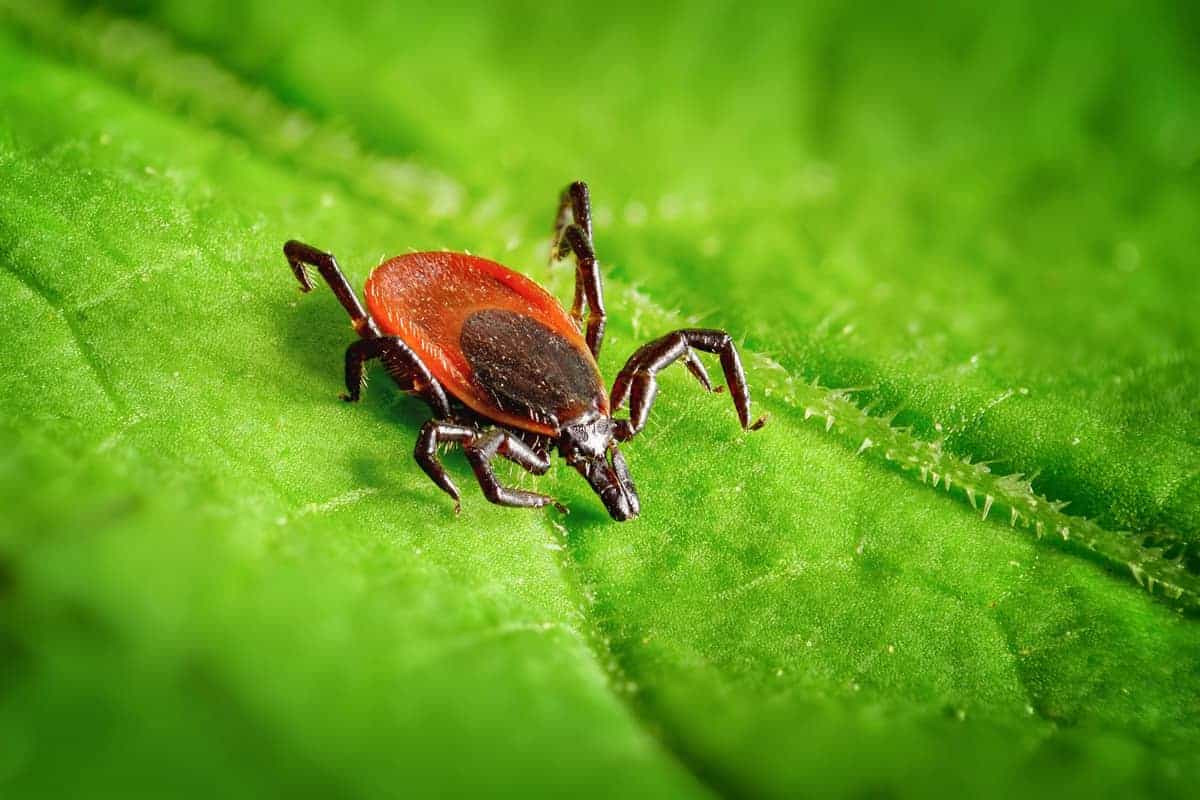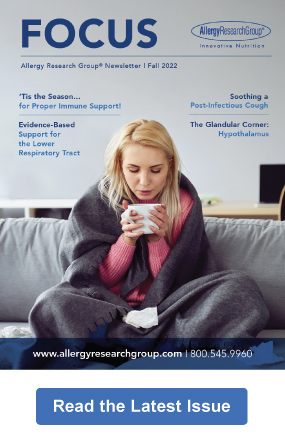Share this post
Clinical evidence supports the use of natural substances for reducing symptoms associated with Lyme disease
We all are becoming more aware of Lyme disease, as the incidence of this tick-borne infection is on the rise, particularly in the endemic regions of the upper Midwest and Northeastern United States.[1] Confirmed cases continue to show up far outside these regions as well, with documented cases in almost all of the continental states of the US yearly.
For some, Lyme disease can become a complex and chronic debilitating condition in part due to the cunning ability of the causative bacteria Borrelia burgdorferi to hide and change forms in the body. B. burgdorefi can switch to a cystic form, build a protective wall around itself known as a biofilm, and change its expression of proteins and genes to enable its survival in the human body.[2],[3],[4] Coinfections such as Bartonella, Ehrlichia, Anaplasma and Babesia are commonly transmitted with B. burgdorferi, [5],[6] and not only lead to symptoms associated with their presence, but also can increase Lyme disease severity.[7]
We not only see resistance [of tick-borne infections] to treatment with antibiotics, but also to botanicals, necessitating a multifactorial approach of rotating various botanicals and other natural substances through a long course of treatment.
Because of these many factors, we not only see resistance to treatment with antibiotics, but also to botanicals, necessitating a multifactorial approach of rotating various botanicals and other natural substances through a long course of treatment. Symptoms also can often worsen through the course of treatment, due to a reaction referred to as “die-off” or “Herxing” that is caused by the by-products associated with bacterial lysis increasing the inflammatory response in the body. These products of bacterial die-off not only stimulate a further immune response and inflammation, but can also adversely affect organ and systemic function, sometimes critically, in patients with Lyme disease.[8],[9]
It is important to consider options for treatment that can address each of these challenges distinctly when supporting a patient with Lyme disease. Additionally, support for symptom palliation also is often necessary to help alleviate the chronic symptoms of fatigue, brain fog, and pain that often come with this disease.
Systemic support to address the cause and the symptoms
Cat’s claw (Uncaria tomentosa), also known in Spanish as uña de gato, is ideally suited in the Lyme setting, as in addition to its immune-supportive actions it has been shown to have anti-inflammatory, anti-arthritic, and antioxidant effects, and supports cognitive function as well.[10] Cat’s claw has been shown to enhance proliferation of infection-fighting white blood cells, also increasing the time they are active and doing their job in the body.[11],[12] Cat’s claw has been shown in both rheumatoid and osteoarthritis to significantly improve symptoms of joint swelling and pain, which many patients also may experience with Lyme disease.[13],[14] Cat’s claw also is a potent inhibitor of tumor necrosis factor (TNF)-α, a primary pro-inflammatory protein associated with the acute immune system response.[15] In multiple animal studies, cat’s claw has been demonstrated to protect the nervous system and improve memory as well.[16],[17]
Lactoferrin has been shown to neutralize lipopolysaccharide (LPS), a primary contributor to the “die-off” reaction, also directly inhibiting the immune system response caused by LPS.
Lactoferrin, a glycoprotein found in milk and at much higher concentrations in colostrum, has broad antimicrobial action against parasites, bacteria, fungi, and viruses.[18] It has been shown to inhibit the growth of Babesia spp.,[19] one of the common co-infections, and has an inhibitory effect on bacterial biofilms,[20] including that of B. burgdorferi.[21] Lactoferrin has been shown to neutralize lipopolysaccharide (LPS),[22] a primary contributor to the “die-off” reaction, also directly inhibiting the immune system response caused by LPS.[23],[24] Similar to cat’s claw, lactoferrin has been shown in several studies to decrease levels of TNF-α as well.[25]
Chitosan, a biopolymer derived from the shell of crustaceans, supports the removal of a wide array of toxins from the body, including mold toxins, heavy metals, and LPS.[26],[27],[28] Chitosan is able to chelate the metals manganese and zinc,[29],[30] both of which are necessary for the lifecycle and function of B. burgdorferi.[31],[32] Chitosan has been shown to act as a biofilm-disrupting agent, particularly when the chitosan is of low molecular weight.[33],[34] Low molecular weight chitosan has also been shown to reduce symptoms attributed to the die-off reaction in Lyme disease.[35] In the gut, the larger chitosan particles have a prebiotic effect, promoting the growth of Bifidobacterium spp. and Lactobacillus spp., which are predominant healthy flora that also support the reduction of inflammation and a normal immune response.[36],[37],[38]
Low molecular weight chitosan has also been shown to reduce symptoms attributed to the die-off reaction in Lyme disease.
Finally, support for cellular function and repair may help to reduce the fatigue associated with Lyme disease. Lipid replacement therapy, the supplementation of glycerophospholipids that make up the body’s cellular membranes, in combination with additional antioxidants such as coenzyme Q10 (CoQ10) supports cellular function and repair, in particular that of the mitochondria, the energy-generating units found in all of the cells. Multiple studies utilizing glycerophospholipids as a monotherapy or in combination with additional nutrients have shown positive outcomes in settings of chronic fatigue, including that specifically attributable to Lyme disease, also leading to improvements in mitochondrial function.[39],[40],[41]
Although the health challenges associated with tick-borne infections are complex, therapies such as these, or a combination thereof, are an excellent evidence-based starting point that may yield notable improvements.
Click here to see References
[1]Centers for Disease Control and Prevention, National Center for Emerging and Zoonotic Infectious Diseases, Division of Vector-Borne Diseases. “Lyme Disease Data Tables.” Lyme Disease. Centers for Disease Control and Prevention. Last updated November 1, 2017. Accessed April 2, 2018.
[2] Zajkowska J, et al. [Atypical forms of Borrelia burgdorferi–clinical consequences]. Pol Merkur Lekarski. 2005 Jan;18(103):115-9.
[3] Singh SK, Girschick HJ. Molecular survival strategies of the Lyme disease spirochete Borrelia burgdorferi. Lancet Infect Dis. 2004 Sep;4(9):575-83.
[4] Sapi E, et al Characterization of biofilm formation by Borrelia burgdorferi in vitro. PloS One. 2012 Oct 24;7(10):e48277.
[5] Lantos PM, Wormser GP. Chronic coinfections in patients diagnosed with chronic lyme disease: a systematic review. Am J Med. 2014 Nov;127(11):1105-10.
[6] Mitchell PD, et al. Immunoserologic evidence of coinfection with Borrelia burgdorferi, Babesia microti, and human granulocytic Ehrlichia species in residents of Wisconsin and Minnesota. J Clin Microbiol. 1996 Mar;34(3):724-7.
[7] Diuk-Wasser MA, et al. Coinfection by Ixodes Tick-Borne Pathogens: Ecological, Epidemiological, and Clinical Consequences. Trends Parasitol. 2016 Jan;32(1):30-42.
[8] Maloy AL, Black RD, Segurola RJ Jr. Lyme disease complicated by the Jarisch-Herxheimer reaction. J Emerg Med. 1998 May-Jun;16(3):437-8.
[9] Webster G, et al. Jarisch-Herxheimer reaction associated with ciprofloxacin administration for tick-borne relapsing fever. Pediatr Infect Dis J. 2002 Jun;21(6):571-3.
[10] Gonçalves C, et al. Antioxidant properties of proanthocyanidins of Uncaria tomentosa bark decoction: a mechanism for anti-inflammatory activity. Phytochemistry. 2005 Jan;66(1):89-98.
[11] Wurm M, et al. Pentacyclic oxindole alkaloids from Uncaria tomentosa induce human endothelial cells to release a lymphocyte-proliferation-regulating factor. Planta Med. 1998 Dec;64(8):701-4.
[12] Domingues A, et al. Uncaria tomentosa aqueous-ethanol extract triggers an immunomodulation toward a Th2 cytokine profile. Phytother Res. 2011 Aug;25(8):1229-35.
[13] Mur E, et al. Randomized double blind trial of an extract from the pentacyclic alkaloid-chemotype of uncaria tomentosa for the treatment of rheumatoid arthritis. J Rheumatol. 2002 Apr;29(4):678-81.
[14] Piscoya J, et al. Efficacy and safety of freeze-dried cat’s claw in osteoarthritis of the knee: mechanisms of action of the species Uncaria guianensis. Inflamm Res. 2001 Sep;50(9):442-8.
[15] Sandoval M, et al. Cat’s claw inhibits TNFalpha production and scavenges free radicals: role in cytoprotection. Free Radic Biol Med. 2000 Jul 1;29(1):71-8.
[16] Mohamed AF, et al. Effects of Uncaria tomentosa total alkaloid and its components on experimental amnesia in mice: elucidation using the passive avoidance test. J Pharm Pharmacol. 2000 Dec;52(12):1553-61.
[17] Lee SC, et al. Effects of repeated administration of Uncaria hooks on the acquisition and central neuronal activities in ethanol-treated mice. J Ethnopharmacol. 2004 Sep;94(1):123-8.
[18] Moreno-Expósito L, et al. Multifunctional capacity and therapeutic potential of lactoferrin. Life Sci. 2018 Feb 15;195:61-64.
[19] Ikadai H, et al. Inhibitory effect of lactoferrin on in vitro growth of Babesia caballi. Am J Trop Med Hyg. 2005 Oct;73(4):710-2.
[20] Singh PK, et al. A component of innate immunity prevents bacterial biofilm development. Nature. 2002 May;417(6888):552.
[21] Haenel D, Sapi E. Significant antimicrobial effects of lactoferrin on Borrelia burgdorferi biofilm. University of New Haven. Poster.
[22] Zhang GH, et al. Neutralization of endotoxin in vitro and in vivo by a human lactoferrin-derived peptide. Infect Immun. 1999 Mar;67(3):1353-8.
[23] Elass-Rochard E, et al. Lactoferrin inhibits the endotoxin interaction with CD14 by competition with the lipopolysaccharide-binding protein. Infect Immun. 1998 Feb;66(2):486-91.
[24] Mattsby-Baltzer I, et al. Lactoferrin or a fragment thereof inhibits the endotoxin-induced interleukin-6 response in human monocytic cells. Pediatr Res. 1996 Aug;40(2):257-62.
[25] Drago-Serrano ME, et al. Lactoferrin: Balancing Ups and Downs of Inflammation Due to Microbial Infections. Int J Mol Sci. 2017 Mar 1;18(3).
[26] Quintela S, et al. Ochratoxin A removal from red wine by several oenological fining agents: bentonite, egg albumin, allergen-free adsorbents, chitin and chitosan. Food Addit Contam Part A Chem Anal Control Expo Risk Assess. 2012;29(7):1168-74.
[27] Davydova VN, et al. Interaction of bacterial endotoxins with chitosan. Effect of endotoxin structure, chitosan molecular mass, and ionic strength of the solution on the formation of the complex. Biochemistry (Mosc). 2000 Sep;65(9):1082-90.
[28] Solov’eva T, et al. Marine compounds with therapeutic potential in gram-negative sepsis. Mar Drugs. 2013 Jun 19;11(6):2216-29.
[29] Guan B, et al. Removal of Mn (II) and Zn (II) ions from flue gas desulfurization wastewater with water-soluble chitosan. Sep Purif Tech. 2009 Mar 12;65(3):269-74.
[30] Wu ZB, Ni WM, Guan BH. Application of chitosan as flocculant for coprecipitation of Mn (II) and suspended solids from dual-alkali FGD regenerating process. J Haz Mat. 2008 Apr 1;152(2):757-64.
[31] Troxell B, et al. Manganese and zinc regulate virulence determinants in Borrelia burgdorferi. Infect Immun. 2013 Aug;81(8):2743-52.
[32] Aguirre JD, et al. A manganese-rich environment supports superoxide dismutase activity in a Lyme disease pathogen, Borrelia burgdorferi. J Biol Chem. 2013 Mar 22;288(12):8468-78.
[33] Pu Y, et al. In vitro damage of Candida albicans biofilms by chitosan. Exp Ther Med. 2014 Sep;8(3):929-934.
[34] Chávez de Paz LE, et al. Antimicrobial effect of chitosan nanoparticles on streptococcus mutans biofilms. Appl Environ Microbiol. 2011 Jun;77(11):3892-5.
[35] Hines SW. Nano-Particle Chitosan: New Hope for Lyme-Related Herxheimer Symptoms. Focus. 2007 July:9-10.
[36] Lee HW, Park YS, Jung JS, et al. Chitosan oligosaccharides, dp 2-8, have prebiotic effect on the Bifidobacterium bifidium and Lactobacillus sp. Anaerobe. 2002 Dec;8(6):319-24.
[37] Cani PD, et al. Selective increases of bifidobacteria in gut microflora improve high-fat-diet-induced diabetes in mice through a mechanism associated with endotoxaemia. Diabetologia. 2007 Nov 1;50(11):2374-83.
[38] Roselli M, et al. Probiotic bacteria Bifidobacterium animalis MB5 and Lactobacillus rhamnosus GG protect intestinal Caco-2 cells from the inflammation-associated response induced by enterotoxigenic Escherichia coli K88. Brit J Nutr. 2006 Jun;95(6):1177-84.
[39] Nicolson GL, et al. Lipid replacement therapy with a glycophospholipid formulation with NADH and CoQ10 significantly reduces fatigue in intractable chronic fatiguing illnesses and chronic Lyme disease patients. Int J Clin Med. 2012 May 29;3(03):163.
[40] Nicolson GL. Lipid replacement/antioxidant therapy as an adjunct supplement to reduce the adverse effects of cancer therapy and restore mitochondrial function. Pathol Oncol Res. 2005;11(3):139-44.
[41] Agadjanyan M, et al. Nutritional supplement (NT Factor™) restores mitochondrial function and reduces moderately severe fatigue in aged subjects. J Chronic Fat Syn. 2003 Jan 1;11(3):23-36.
The information provided is for educational purposes only. Consult your physician or healthcare provider if you have specific questions before instituting any changes in your daily lifestyle including changes in diet, exercise, and supplement use.
Share this post
Dr. Carrie Decker
Related posts
Turmeric: A Golden Remedy for Musculoskeletal Health
Curcuminoids, the famous active compounds from turmeric, deliver benefits for joint health and exercise recovery Liquid gold. Golden milk. That brilliant saffron-hued spice. We hear a lot about turmeric these days—also known as Curcuma longa—a member of the ginger family, and native of Southeast Asia.[1] Valued for its brilliant hue and distinctive spicy-bitter flavor,…
Response to CBS News Report: Do Probiotics Actually Do Anything?
They got a lot right, but we have a few (cited) details to add to the conversation By Mike Grochocki, RD, LDN On June 28th, 2020 the CBS News show 60 MINUTES aired a segment on probiotics, which have become wildly popular in both professional and retail nutritional supplement markets. The main question CBS…
The Multivitamin Debate
What does science say about multivitamin and mineral supplementation? Dietary supplement use is common in the United States, with more than half of the population using such products.[1],[2],[3],[4] Similarly, a majority of health professionals, including physicians and dieticians, use dietary supplements themselves and recommend them to patients.[5],[6],[7] Among supplement users, multivitamin and mineral supplements…
What is autoimmune disease?
How a confused immune system can do harm. The immune system is brilliantly designed to protect us from the complications of infection, injury, and disease – but it isn’t perfect. In a condition known as autoimmunity, the immune system can cause harm by attacking the body’s own cells, tissues, and organs. Let’s take a closer…
Easing Pain, Naturally
Drug-free, natural remedies for pain Just about nobody likes to be in pain. That may be why there are so many drugs out there nowadays that effectively treat it, and why we so consistently seek them out. While synthetic analgesics like opioids, NSAIDs, and acetaminophen can be effective in quieting pain, these drugs also…
Natural Support for the Fight Against Infections
Andrographis, cat’s claw, humic acid, and monolaurin In 2020 we became all too aware of how infectious disease seriously threatens the health of people worldwide. Fortunately, there is ongoing investigation of nutrients, herbs, and other natural substances that may help fight common injurious microbes, especially when conventional medicine fails to deliver.[1] In today’s post…
Categories
- Botanicals (56)
- GI Health (53)
- Healthy Aging (121)
- Immune Support (39)
- In The News (39)
- Kids Health (21)
- Stress and Relaxation (50)
- Uncategorized (1)
- Video (9)
- Vitamins & Minerals (51)




